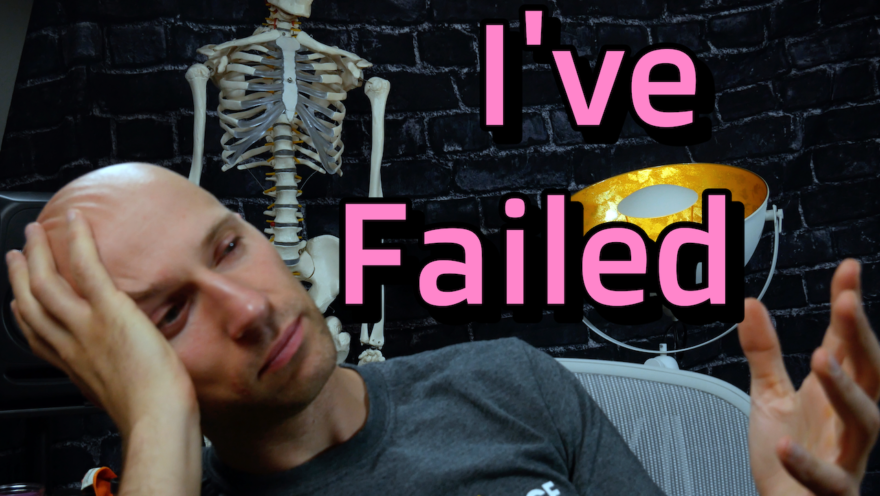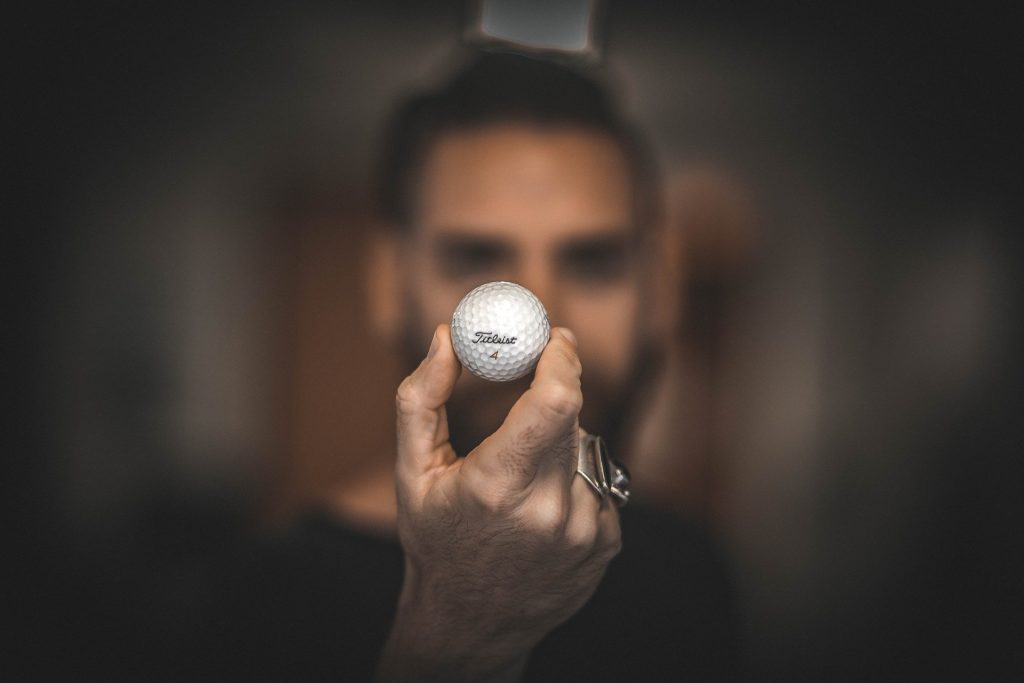Table of Contents
Rarely do we discuss our mistakes. I’ll be the first
We learn some of our best lessons from the mistakes that not only we’ve made, but those before us.
Yet rarely does one discuss the times that they’ve failed. Instead, it’s all puppies and rainbows on your social network of choice. Everyone has their best life and best practice all up in there.
But without that transparency, without sharing how we fail, we miss out on an incredible learning opportunity. We may fall victim to similar mistakes that can happen throughout both patient care and working with your supreme gym clientele.
That ends today.
I’m going to share with you 5 mistakes that I’ve made in my physical therapy career, what I’ve learned from those problems, and what I’m doing differently. Let ya boi screw up, so you don’t have to.
Check out the video, podcast, and blog below to learn about it!
and the podcast version
Not aligning with my mentor
I had just finished an incredible mentorship with Daddy-O Pops Bill Hartman while in PT school, and I knew exactly how I wanted to practice; like him.
I wanted a setup like Bill had, I wanted to work with the supreme clientele Bill did, I wanted to help people the way Bill did. I went all-in on his approach, and he continues to be my biggest influence to this day. I aligned with him on so many fronts, and that’s why I was able to get so much out of the professional relationship we have.
In fact, I was so juiced up about the profession, that I thought YES, let’s keep this learning going, let’s do an orthopedic residency right out of PT school. Then I’ll really be killin’ da game.
Big mistake.
While I learned a great deal at my residency, especially on the pathology and differential diagnosis side of things, as well as interacting with a wide variety of doctors, the bulk of my time there was spent quarreling and causing trouble with a few of my mentors, trying to justify the way I wanted to practice.
It wasn’t that the residency was inherently bad or the people in it were not good, or that I was da shit (see a later mistake), but the issue was that my treatment values didn’t align with theirs. The way I wanted to practice wasn’t set up in that situation.
I didn’t align with my mentor, and because of that the amount that I could’ve learned suffered. That’s totally on me.
If I had done it over again, I would’ve gotten in a similar setup to what I had when I was working with Bill. A similar mentor, hell, maybe even Bill.
Because in order to maximize the learning process, especially in the beginning, you have to go all in. You can’t be skeptical. You have to assume all that they say is gospel (for a little while).
The reason for this is that in this relationship, you are trying to save yourself time. Learn from their mistakes, learn their process. Because when you are first starting out, you have no process. A mentor serves to save you mistakes, time, and get your thought process kick-started.
Trust what they say, then verify (cue my Ronald Reagen impression).

If your values don’t align, then you can’t trust the process, and you won’t get the most out of the mentorship experience.
Having too big of an ego
When I got out of my internship with Bill, the results I was getting were next level. It was remarkable how many people we helped.
I let that get to my head, and it caused problems in many of my first jobs. Namely, because I thought my way was the only way to help people.
The Dunning-Kreuger effect is hell.
In some respects, the way I did things was superior. I was getting great results on some of the objective outcome measures we did, fellow clinicians would ask me for help, it was wild.
But the problem was I was still green. There was still a lot that I hadn’t seen. There was a lot that I needed to learn but didn’t have the reps needed to get that learning.
Because of this scenario, my ego closed off my ability to learn certain topics and from my colleagues, burning bridges in the process.

The sooner you can kill your ego, the better. Have a beginner’s mindset for as long as you can, even with thought processes that you disagree with.
As I had mentioned in the last bullet point, trust, but verify. Assume that what someone says is true, and do all that you can to frame their thought process or argument in the strongest manner possible; whether it’s researching to support/refute what they say, or thinking through it with thought experiments. We call this steel manning the argument, making it as strong as possible.
Then, and only then should you be able to poke holes. You are the other person who will only get better after this.
Ignoring patient preference
As you might know, I’m WAY big into breathing-based stuff. Hell, there’s good research showing that if you don’t breathe, you’ll die. It’s important.
So of course, I’m going to do all in my power to help people with these methodologies.
Then I treated that nurse.
Early in my career, I saw this nurse who had neck pain. I did some breathing stuff in the beginning, and we got some decent changes with her on the first session. YAY!
Then she talked to one of her doctor friends, who said what I was doing was crap.
From here, we had a tumultuous relationship. She wanted me to ONLY look at her neck and would get upset if I checked other areas of her body.
Despite my best efforts to educate her and my rigidity to give her what she wanted, I ended up failing with this patient and she worked with someone else.
While some of my failure came from not educating her in the best fashion or getting major results from the get-go, the biggest piece was ignoring the patient’s preference, what the patient wanted. Because I neglected to do this, I didn’t make the patient feel validated, lost trust with her, and couldn’t help her.
You can have the most amazing treatment plan, the best techniques, the most evidence-based thought process that will make all your Twitter followers proud, but no plan of care survives contact with the patient.
I was speaking with Bill one time, and he said something to the likes of the hardest part of working with patients is the human component.
Patient interaction is messy, it’s not crystal clear like the biomechanics can oftentimes be. You have their beliefs, past experiences, fears, preferences, all clouding the process.
You can’t ignore their preference.
But how can you give the client what they need while satisfying their wants?
First, listen. Shut up and listen. Don’t butt in when they are talking. Listening to their story lets them know that you care. That what they say, matters.

Second, address their fears. You have to touch the area that hurts, look at them, rule out red flags, be thorough.
Lastly, let them know it’s going to be okay, then outline your plan of attack for them. Let them know that if we address these areas, we can likely make some nice changes.
Then finish by answering any questions they may have. All of these components build trust and will ensure you have the best outcome.
Lastly, if there’s something they want, whether it’s hands-on, ultrasound (yuck), anything, give it to them as long as it won’t hinder progress. If you can spare a 5-minute ultrasound, even if it does nothing, do it. Then give ‘em the stuff they need.
Being afraid to make recommendations
I had this one patient who I tried several things to help, but nothing seemed to get lasting changes. I could get some motion improvements, but they continued to complain about neck tension and discomfort.
I finally decided to look at some upper airway-related stuff and found that they had a significant tongue-tie.
My first thought was CRAP, the upper airway stuff is a huge rabbit hole to go down (trust me, I’m hanging with the mad hatter on the regular), and I don’t know if they are willing to go this route.
I overcame my fears and said something, and sure enough, they were okay and were grateful that I said something. They ended up getting the release and noticed some nice improvements.
My mistake here was I should’ve said something sooner, but that I was afraid to make the recommendation because I wasn’t sure how the patient would react.
Another example of this was a golfer I was working with. I try my darndest to keep people doing the tasks they love in so far as they don’t hurt. We’d get some changes within the session, but then he would go golf and then be hurting like hell. Sadly, he couldn’t lay off of golf at this point in time, and we opted to hold physical therapy until he could take some time off.
While in this case, I kept up with patient preference (he wanted to play golf), I did so to the detriment of him getting better. Ideally, he would’ve laid off of golf until we built him up to be able to play pain-free.
Here, I was afraid to make that recommendation.
But the thing is, you are the professional, you have to make recommendations that are in the patient’s best interest. You want to provide them with all and any information that can help them reach their goal. Being afraid to make recommendations, even if they are outside the box, can limit the progress of the patient.
I run into this issue a lot if I suspect someone would benefit from some treatment that is out of the box, be it upper-airway or going to vision therapy. What do we do there?
The simple fix: give the patient or client options.
When I went to see Dr. Hockel for dental treatment, he gave me a list of options that could help me with my energy issues. Although he gave me his recommendation of what might be most effective, he ultimately let me decide the route to go. Explaining things in this way was so empowering as a patient.
I think we can steal a page from his playbook and do the same here for a patient. You can give someone various options, and ultimately let the patient decide the route that will work best for their current scenario.
For our golfer above, this might look like this:
- Best: Complete rest from golf, begin treatment with me, follow this training program
- Better: Manage load on golf (reduce frequency or intensity), perform these exercises, try this warmup
- Good: Try these few moves and use these symptom-management techniques (taping, anti-inflammatories) in the meantime, keep golfing as you are
In the above examples, I framed things in a manner of what would likely be most effective, and what could possibly work, then I give the patient a choice.
Realistically, I never know what will be the thing that works for the patient, but providing realistic options and chances of success with each informs the patient’s expectations and makes them active in their care. Give the patient ownership, yet be realistic with expectations.
Relying too heavily on any one system
I was really into neurodynamics at one point in time and was flossing the F out of someone’s median nerve. We got some symptom changes, but they still persisted significantly.
Then my buddy came in and tested some different things. Turns out he was missing 30 degrees of shoulder external rotation. Technically, I couldn’t even express the full neurodynamic test.
Oops.
Then I was in basketball. I couldn’t get changes to stick on this one player. He was doing the moves I gave him consistently but kept coming back tight.
The solution: get him paired with a dentist, ignoring that he was playing tons of games, not moving spectacular under load, and minimally training.
Oops.
The issue in both of these stories was I was being myopic. I could only look at helping the person in front of me through only one lens, ignoring all other potential factors that could help my supreme client.
And because of that, I failed.
It wasn’t until the D-league that I recognized how controlling many different variables could lead to a significantly higher success rate of becoming and staying healthy. In the d-league, I was able to impact rehab, training, workload management, nutrition, and to some extent, sleep.
When I could influence more variables, I could get WAY faster outcomes, without having to go to fringe ends with any one system.
Although to really get the most out of any methodology, you have to go all-in learning-wise, no system, method, or thought process has all the answers for our peeps.
You can’t do a bunch of stuff to increase movement options and expect to out-do a significantly high workload. Conversely, you can’t just ask someone the change their squat stance if they have significant motion restrictions that might impede their ability to attain certain positions.
The best way to help your supreme clientele is to draw upon many different systems and methods to help them succeed, including other practitioners.
Then and only then, do you have the best possibility of succeeding
Sum up
Mistakes are our best learning opportunities, and here’s what I’ve learned:
- Align with your mentor to get a jump start on your career
- Minimize your ego so you can enhance your ability to learn
- Respecting patient preference increases buy-in and adherence
- Make recommendations that are in the patient’s best interest, even if they are the unpopular thing to say
- No one system has all the answers, make your system as comprehensive as possible
What mistakes have you made and how’d you learn from them? Comment below and let the fam know!
Song credits
- Heartbreaking by Kevin MacLeod | https://incompetech.com/
Music promoted by https://www.chosic.com/free-music/all/
Creative Commons Creative Commons: By Attribution 3.0 License
http://creativecommons.org/licenses/by/3.0/
- Dreams Come True by Purrple Cat | https://purrplecat.com/
Music promoted on https://www.chosic.com/free-music/all/
Creative Commons Attribution-ShareAlike 3.0 Unported (CC BY-SA 3.0)
https://creativecommons.org/licenses/by-sa/3.0/
- Floating Castle by Purrple Cat | https://purrplecat.com/
Music promoted on https://www.chosic.com/free-music/all/
Creative Commons Attribution-ShareAlike 3.0 Unported (CC BY-SA 3.0)
https://creativecommons.org/licenses/by-sa/3.0/
- TRIPPIN COFFEE by Audionautix | https://audionautix.com/
Music promoted by https://www.chosic.com/free-music/all/
Creative Commons Attribution 4.0 International (CC BY 4.0)
https://creativecommons.org/licenses/by/4.0/
- Morning Routine by Ghostrifter Official | https://soundcloud.com/ghostrifter-official
Music promoted by https://www.chosic.com/free-music/all/
Creative Commons CC BY-SA 3.0
https://creativecommons.org/licenses/by-sa/3.0/
- Midnight Stroll by Ghostrifter Official | https://soundcloud.com/ghostrifter-official
Music promoted by https://www.chosic.com/free-music/all/
Creative Commons CC BY-SA 3.0

